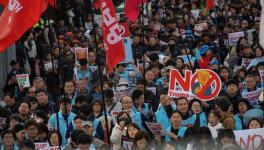What do the Upcoming US Elections Mean for the Working Class of the US?
Joe Biden is joined by former president Barack Obama at a campaign rally. Photo: Twitter
With one day before the U.S presidential elections, tensions are growing and all sectors are waiting anxiously not only for election day, Tuesday, November 3, but wondering anxiously on what will take place on the days and months to come.
Different analysts have come to the conclusion that these elections are the elections with the greatest significance and socio-political implications since the US Civil War.
In addition to the economic crisis that has been under development and exploded in 2007/2008, and its implication for working class and elite sectors in the U.S, there are at least five factors impacting the current elections, and making them unprecedented.
In the last 8 months,
1- There has been the deepening of an economic crisis with exorbitant unemployment numbers and the continuous loss of social and economic protection for the working class.
2- We have experienced the negligence and ineptitude of the Trump administration in the face of a global health crisis – with numbers that continue to grow and without any containment plan.
3- In April, we saw the defeat of Bernie Sanders, who accumulated the support of various sectors of the working class and mounted a campaign that highlighted demands from historically marginalized communities. Bernie lost the Democratic Party nomination, and there wins Sen. Joe Biden.
The result of that decision by the majority of the Democratic Party left thousands of people and organizations that joined Bernie’s campaign, mostly young people, in a space of discouragement and hopelessness in relation to the electoral process. Historically, Biden has represented the traditional, conservative, capitalist and imperialist sectors of the Democratic Party. In this sense, the crisis of legitimacy that the bourgeois U.S. democracy has been experiencing, and that gave birth to Trump, was once again proven. The ruling class is unwilling to have their political systems move, even if moderately, towards more progressive governance.
The crisis of legitimacy has deepened during these months of pandemic and social unrest. At the same time, there is not a united movement (or front) from the working class that has moved towards the creation of a third political option outside the two political wings of the bourgeoisie.
The Democratic Party, as always, has reached this understanding and is taking advantage of this scenario to gather strength and advance its agenda under the banner of “all united for a better future.” Democrats have absorbed the leadership of a broad coalition against Trump. And this represents a great challenge for social movements.
Historically and in the current context, many progressive sectors and social movements have been subordinated to the democratic wing of the bourgeoisie, although many of the most damaging policies for the working class in the last 30 years have been led by Democrats.
4- Among the key factors that make this moment historic and unprecedented is Trump. The election of Trump is an expression of the political and economic crisis in the United States that has been underway for at least more than a decade. Having an openly racist, misogynistic, xenophobic and fascist president who has touched the interests of sectors of the ruling class has created a slightly more public polarization within the bourgeoisie and its parties.
In the social sphere, white supremacy and its militarized groups have re-emerged and been strengthened with great support from the State. In parallel, a broad, anti-Trump coalition has been created, which in this context, is led by the Democratic party.
5- And there is also, the social explosion that overflows at the end of May after the murder of George Floyd and the deepening of a convergence of crisis. At this very moment, there are communities that are still in the streets protesting and being violently repressed by militarized police.
This growing movement that continues to take the streets demanding a number of rights for the workings class, some under the banner of Black Lives Matter, are being channeled to the Democratic campaign of Biden, under this anti-Trump coalition. However, the Democrats do not have any proposal or perspective of structural change. This is something that social movements and political organizations need to be clear about and explore how to deepen this contradiction.
These are some key factors that we estimate have been the engine that has generated the mobilization of millions of people towards the electoral process. Something unprecedented in the last 100 years. So far, an estimated 86 million people have exercised their right to vote early – either in person or by mail. This number is seven times more than the 6 million who had voted early during this time in 2016.
It is important to understand this scenario, because the force that has moved this large number of voters, of which more than 200 thousand are first voters between the ages of 18 – 25, is not their conviction and commitment to the system. Specifically, those who are voting for the Democratic party, it is not necessarily a commitment to the Democratic Party and its agenda, but rather it is a vote against fascism and racism, and against what Trump stands for. This also key and very important for social movements. How to position ourselves and organize around the discontent of the population, and this popular vote against what capitalism and white supremacy, is crucial to advance and strengthen us as a movement towards the next stage within the class struggles in this country.
For months now, and as a result of COVID-19, voting options have expanded. In other words, voting by mail and early voting have been activated, which in some states had not been used in a few decades.
It is important to understand how the so-called democracy works in the U.S. Not all states are governed by the same law. There are states that allow votes by mail and when these are marked by the postal service on November 3, even if they arrive several days after the elections, they count. And there are states in which this is not accepted. This creates a problem, because in a national process the states have different voting rules. The difference in rules per state are part of the history of slavery where some states declared themselves free from slavery, and other Confederate states maintained slavery, and once slavery was legally abolished nationally, they adopted laws that limited the participation of black people in political processes.
The suppression of votes in this country is not the result of the Trump administration, it is a structural problem that Trump and the Democrats are exploiting to position themselves at this juncture.
Trump, from his racist tradition, and for several months, has launched a campaign against the expansion of voting options and has called fraud. He has even made attacks on the postal service and promoting the need to cut its budget. In this campaign against the right to vote and popular participation in the electoral process, the appointment of the new Republican judge to the Supreme Court (Barrett) has served Trump well.
From the supreme court, they can invalidate hundreds of thousands of votes. Right now, there are states like Pennsylvania that have been asked to put votes that arrive in the mail separate from in-person votes to determine their validity after the election. This is one of several examples of vote suppression taking place today, there are states like Wisconsin and Texas in the legal process of determining the invalidation of votes.
In the crippled democracy of the U.S, we also find that popular votes are not what determines the presidential victory. That is why it is much more important for candidates to win states. Hence, the importance of States such as Florida, Wisconsin, North Carolina, Texas – which have historically been the “battleground battle,” and where one or the other political wing of the bourgeoisie can win. The states elect representatives to vote at the electoral college which is where the president is elected. Now, that sounds more amicable and less complicated than it actually is. The states are mostly controlled by Republicans- Republicans control 30 states and Democrats 19. Twenty two of the 30 states controlled by Republicans have no Democratic governor to dispute representation in the electoral college. These 22 states represent 219 electoral college votes, and 270 are needed to secure the presidency.
In 2016, Hilary Clinton won the popular vote, but state representation within the electoral college voted for Trump. And one of the things that the Trump campaign is seeking to guarantee is precisely a representation from the states that re-elect him. That is not a distant possibility. It can happen again.
Now, what is generating the most tension and discord, apart from the possibility of four more years of Trump, is not necessarily the way in which the suppression of votes or the issue of the electoral college is being carried out. Not least important, but as I mentioned earlier, this is historical and ongoing within the crippled democracy of this country. What is causing tension, and what has not happened since the late 1800’s is the possibility of a constitutional crisis.
This constitutional crisis can occur in the event that Trump does not concede to a transition of power, if Biden wins. And, everything indicates that he is unwilling to cede the presidency. On several occasions Trump has affirmed this, and has responded to the question of a peaceful transition by stating that “there will be no transition, but rather, a continuation of the presidency.”
Biden would have to win with an extraordinarily large number of votes to be recognized victorious. Furthermore, he would have to win the popular vote and the electoral college, and the Democrats would have to have gain control of the Senate. Even winning in this way, given Trump and the political maneuvers he has set in motion, there would be no peaceful transition.
That Biden wins with the popular vote and the electoral college, is not likely. The margin of difference by which it is estimated that Biden can win with such a victory is very small.
In a scenario like this, the role of the supreme court and its work of invalidating votes in different states is very important to secure Trump’s position. It is also important, Trump’s call to the “proud boys” and supremacist groups to “defend democracy.”
Everything indicates that all obstacles will be sought to guarantee another presidential term under Trump.
There is a chance that Biden will win the popular vote, and lose the electoral college vote. As a result, the Democratic party could contest the process, and not budge. Which would also mean a political and social conflict – with massive mobilizations in the streets, in addition to political and legal procedures.
In any of the scenarios there will be a period of uncertainty- a period between November and January. That is, from the day of the elections until the president is elected and confirmed.
The implications of these elections are of historical proportion and drastic precisely because we are faced with a context of deep crisis and polarization at all levels of society.
In this period of uncertainty, it is estimated that there will be an intensification of social conflicts, and unrest. In the first presidential debate, Trump mandated white supremacist groups such as the “proud boys” to be vigilant and they have taken the streets in some states to confront Democrats, and people protesting in defense of black lives. There are sure to be many obstacles in the voting process on Tuesday including intimidation and possibly violence by these groups at voting centers.
Any result on Tuesday night and including the factor of agitation by the corporate media we can expect mobilizations: with white supremacist groups, with groups that have been in the streets demanding an end to white supremacy and police brutality, and groups that have been involved in the anti-Trump coalition, including sections of the Democratic Party. In addition, there is the factor of a militarized police throughout the country.
We expect more attacks by the state on social movements and political organizations. In recent months, the persecution, criminalization and incarceration of activists and social leaders has increased.
We are estimating that times of great upheaval and social mobilization are coming. This will require that those of us who believe in advancing a revolutionary process from the working class intensify the struggle. We must deepen this political crisis, and stress the contradictions uplifting the demands of the people and social movements, so that the agenda of the working class can be advanced.
Throughout the country, the social movements and political organizations of the left are seeing and analyzing this moment, and preparing to respond to that period of uncertainty, with the intention of intervening through political formation, organization and permanent mobilization:
- Enhancing the historical struggle against the suppression of votes and for the creation of participatory democratic processes in the country;
- Raising the demands of social movements for which the Democratic nor Republican parties have an answer
- Stand against fascism, white supremacy, capitalism and imperialism.
- Protect and strengthen organizations and movements
- Identify the leaders who come out of these processes that can be part of the ranks to advance the class struggle.
- Unify and strengthen a popular movement politically independent of the political wings of the bourgeoisie.
These are intense moments, which bring challenges and opportunities. At last we know that neither party will advance the class struggle. Neither of the two political wings of the US bourgeoisie offers a change to its policy against Venezuela, Cuba, China, Iran – to name a few. And it does not offer a material change to the reality of the majority of people in the United States.
Some of the key questions in this context are, how will we coordinate our efforts, and organize ourselves so that we are not the end tail of the democrat’s anti Trump coalition? And how will we accumulate the people power to respond to this moment as social movements and advance the class struggle in this critical stage?
As social movements, we must maintain, that the only route to any structural change in the U.S. will come through the unity of social movements and its leaders, the creation of a strong mass organization and political organization independent of the bourgeoisie political machine. This is our big challenge!
Courtesy: Peoples Dispatch
Get the latest reports & analysis with people's perspective on Protests, movements & deep analytical videos, discussions of the current affairs in your Telegram app. Subscribe to NewsClick's Telegram channel & get Real-Time updates on stories, as they get published on our website.
























